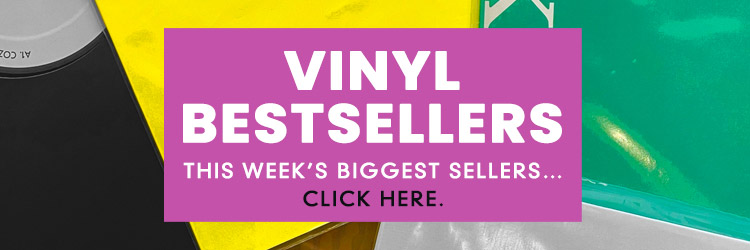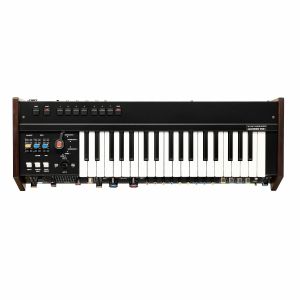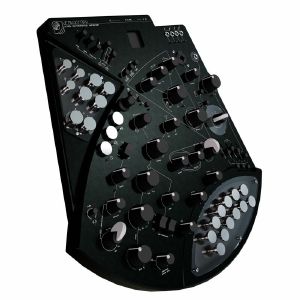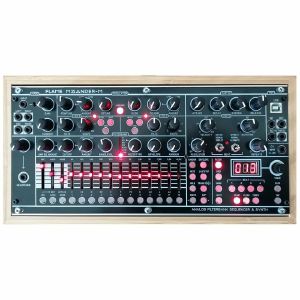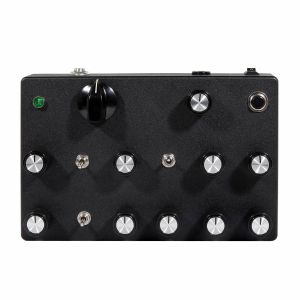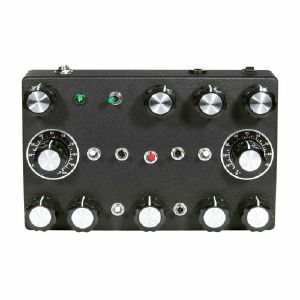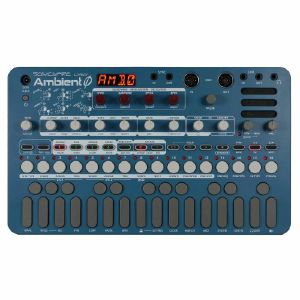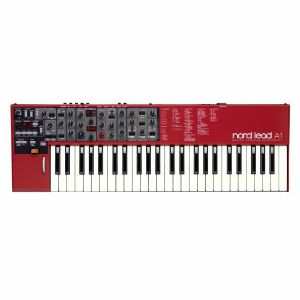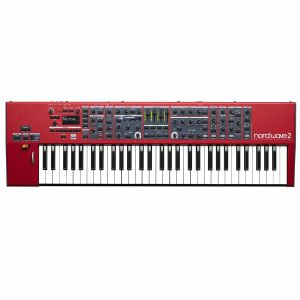Filter
Equipment
Format
Price
New releases today: All genres
The latest All genres vinyl + newly announced preordersReleased in 2021, the miniKORG 700FS was a spectacular recreation of the legendary 1970s miniKORG 700S analogue synthesizer, enhanced with additional functionality that wasn't possible in the original. The miniKORG 700FS was so popular that its limited production run sold out quickly, with significant demand for increased production. Korg has a long history of groundbreaking analogue synthesizers. The miniKORG 700Sm is a tribute to the miniKORG 700, the very origin of Korg's analogue synth history, while being enhanced to meet the needs of today's musicians.
Downsizing the miniKORG 700FS
The miniKORG 700Sm retains all the features of the miniKORG 700FS in an instrument approximately 86% the size of the original. Additionally, the miniKORG 700Sm weighs just 5.8 kg (12.8 lbs), making it easy to transport.
The elements vital to an analogue synth
The character and richness of the sounds produced by the miniKORG 700 could not be realized through analogue modelling. Although it's possible to replicate a circuit by using the same parts and copying the design schematics or circuit board, there's no guarantee that this will reproduce the original sound. This is because the components age over time, dramatically altering the sound. To accurately recreate the original sound, Korg had to rely on the experience and skill of the technicians who worked on the original product.
Korg were able to bring the original sound to life thanks to their team of technicians, who have gained invaluable expertise over the years through their work on numerous synthesizer revival projects. This team was guided by the legendary Fumio Mieda, a Korg engineer since the early 1970s and one of the designers of the original miniKORG 700S. Working closely with Korg's sound designers, they meticulously reproduced the original sound as faithfully as possible. Those who play the miniKORG 700Sm will experience it as a beautifully crafted and authentic recreation of the original.
Beautiful synth leads, thick bass - and more
The miniKORG 700 was Korg's first synthesizer, and produced some of the most recognizable, rich and fattest analogue sounds of the time. The new miniKORG 700Sm features oscillators with an unmistakeable tone and an authentic recreation of the Traveler controller- a signature element of the miniKORG 700- designed to add extraordinary colour and expression to performances. Its sound fits seamlessly in today's music, especially with its standout lead and bass synth tones.
Secondary keyboard possibilities
The miniKORG 700 was originally designed as a secondary keyboard, often placed on top of an organ to expand their sound palette. The miniKORG 700Sm, with its compact and portable form factor, stands out as a powerful solo instrument but also complements stage keyboards like electric pianos and organs perfectly.
The controls on the miniKORG 700 were laid out below its keys in a row, allowing players to easily access them when it was placed on top of another instrument. This intuitive layout remains unchanged, offering simplicity, ease of use, and a unique look that sets it apart from any other instrument.
Expanded functionality When the miniKORG 700 was originally released, electronic components were larger in size, limiting functionality due to the small space inside. Thanks to advancements in technology, there is now room to include a spring reverb as well as a joystick for pitch bend and modulation. The new version also features aftertouch for added expressiveness, as well as an arpeggiator, USB port, MIDI IN connector and a CV/GATE IN jack. Korg have also added memory programs to store settings, something that wasn't available in the early 1970s.
Traveler controller
A unique feature of the miniKORG 700, the Traveler controller, consisted of two parallel sliders located below the keyboard. With these controls, players could adjust the cutoff frequency, with the upper lever controlling the low-pass filter and the lower lever controlling the high-pass filter. This gave players the freedom to adjust the expressive character of the sound according to the position of the levers. By moving the levers to the left and right while playing the keys, wah-wah and muted sounds could be created along with the iconic "traveling" sound.
Since the sound passing through the filter has a lower cutoff frequency and higher cutoff frequency than the frequencies set by the sliders, all frequencies are filtered and thus no sound is heard when the positions of the two sliders are inverted. In other words, making the two sliders cross would in theory produce no sound. To address this, the original miniKORG 700 featured protrusions on the sliders to physically prevent them from crossing.
The design was both a benefit and limitation of analogue circuitry. In the past- and even today- it's impossible to design a filter with perfect characteristics. During the time that the miniKORG 700 was sold, some players would shave off the protrusions on the sliders to allow them to cross, in an attempt to create new sounds. In fact, some models sold internationally did not even have the protrusions to begin with. The miniKORG 700Sm also does not have the protrusions, opening endless sound design possibilities and allowing players to create patches in unique ways.
A second oscillator The miniKORG 700 was a single-oscillator mono synth. One year later 1974, the miniKORG 700S was released with more space added to the left of the keyboard for a controller. This version also introduced a second oscillator, a ring modulator, and other enhancements. The new Sm model is a revival of the 700S, with its expanded functionality, including two oscillators that deliver powerful detuning and thick, penetrating sounds, particularly for bass and lead sounds.
Includes a made-to-fit soft case
The miniKORG 700Sm comes with a custom-made soft case designed to perfectly fit the instrument, ensuring both protection and portability. This case makes it easy to take your miniKORG 700Sm wherever you go, whether you're performing, recording, or traveling, keeping your synth safe and secure.
Free music software bundle
The miniKORG 700Sm comes with a diverse variety of music software including Izotope (featuring "Ozone Elements" which lets you not only create songs but also master them using AI), "Skoove" which will help you improve your keyboard playing skills, "miniKORG 700S" from the Korg Collection software, as well as a wide range of software synths from Korg and other developers.
Specifications
Keyboard: 37 keys (Slim-key, with aftertouch, no velocity sensitivity)
Range: 7 octaves
Waveform: Triangle wave, Square wave, Sawtooth wave, Chorus I, Chorus II
Programs: 14
Input: USB connector (Type B), MIDI IN connector, SYNC IN and SYNC OUT jack (3.5mm monaural mini phone jack), CV IN and GATE IN jack (3.5mm monaural mini phone jack), AUDIO IN jack (6.3mm monaural phone jack, TS unbalanced)
Output: OUTPUT L/MONO and R jack (6.3mm stereo phone jack, TS unbalanced), Headphones jack (6.3mm stereo phone jack)
Power supply: AC adapter (DC 12V)
Power consumption: 9W
Dimensions (W × D × H): 641 x 228 x 107 mm/25.24" x 8.98" x 4.21"
Weight: 5.8 kg/12.79 lbs.
Included items: AC adapter, Traveler knob (without protrusions type) x 2, Soft case Accessories (sold separately)
SQ-CABLE-6 (Patch Cable)
quote 1066370
Uranograph's dual keyboards layout is more than just an input devices - it's the expressive heart of the instrument, offering an intuitive yet deeply responsive interface for performance and sound exploration. Their stainless steel touch plates provide an ultra-sensitive playing experience, responding to the most delicate gestures with precision and nuance. Unlike conventional mechanical keybeds, Uranograph's capacitive surface allows immediate, fluid articulation, enabling new microtonal performance, dynamic phrasing, and real-time sound shaping possibilities.
Uranograph's keyboard is highly responsive to touch, velocity, and aftertouch pressure. Each press translates into a continuous, organic sound variation, making it possible to shape phrases naturally, much like on stringed or wind instruments.By default, pressure is routed to the instrument's VCA/filter, and the envelope sustains level volume. An additional routing can be set to send the intensity of pressure to whatever other parameters you prefer, a dedicated knob is also implemented for instant control of the amount of this. This continuous pressure-sensitive surface offers a playing experience closer to acoustic instruments, bridging the gap between electronic synthesis and natural musical expression.
Uranograph notes output takes advantage of a series of prepared Keyboard, where each key can be easily assigned to any pitch or pure frequency, offering complete keyboard design and tuning flexibility. Whether adhering to traditional Western tuning, exploring Arabic maqams, Indian ragas, Just Intonation, or experimental microtonal divisions, Uranograph provides an expansive range of tonal possibilities. Preloaded with 50+ keyboard layouts Customizable keyboards allow users to design and store personalized layouts. Instant recall ensures seamless transitions between different tonal systems.This adaptability makes Uranograph an ideal instrument for non-standard tuning, enabling deep engagement with diverse musical traditions and avant-garde soundscapes.
Beyond pitch control, Uranograph features a dedicated control keyboard designed for dynamic, hands-on sound transformation. Unlike traditional mod wheels or faders, this touch-based control surface enables intuitive, real-time interaction with synthesis parameters, allowing for expressive, gestural modulation.
The control keyboard is divided into three functional sections: Articulation, Octave Shift, and ModKeys.
Three dedicated articulation plates provide instant access to advanced phrasing techniques and canonic musical articulations found in stringed instruments: glissando, trillo, and staccato:
Glissando: Enables smooth pitch slides between notes
Staccato: Shortens note duration, creating a percussive attack
Trillo: Rapidly alternates between notes
Each articulation can be activated momentarily (by holding the plate) or latched (by tapping once), offering precise control over phrasing. This flexibility allows musicians to engage articulations selectively, shaping expression dynamically within a phrase. They can introduce variation within a note and the successive one or as a general character of the part.
Three faders are implemented on the panel to quickly change the articulation's behaviors.
Four ModKeys serve as fully assignable, pressure-sensitive controllers for precise real-time modulation of synthesis parameters. Each plate dynamically responds to pressure, enabling simultaneous control over multiple parameters. By integrating expressive modulation gestures with the performance keyboard, players can shape fluid, evolving textures that respond organically to touch - enhancing expressivity and immediacy in synthesis. ModKey destinations and maximum values can be adjusted in the menu and stored during pattern changes.
At the bottom, two integrated octave shift plates provide instant transposition, allowing players to increase or decrease the octave range in momentary or latching modes:
Momentary Mode: Holding a plate temporarily shifts the octave.
Latching Mode: Tapping once locks the new octave until changed.
Bend Mode: Pressing both octave plates simultaneously activates the pitch bend feature, allowing for fluid and expressive pitch manipulation, similar to bending notes on stringed instruments.
Uranograph's core is built on additive and phase morphing synthesis, offering an innovative approach to shaping its five oscillators. The primary sound source is a core oscillator that starts as a pure sine wave and transforms through multiple synthesis techniques, generating a spectrum of timbres from warm, organic tones to sharp, digital textures. Uranograph provides multiple methods to modify the primary sine wave, introducing even and odd harmonics and sidebands, shaping both harmonic and inharmonic spectra. By altering the phase of a sine wave without changing its fundamental frequency, Uranograph transforms simple waveforms into dynamically evolving textures that range from warm and bell-like to metallic and aggressive:
Size (Phase Warping & Spectral Expansion): Stretches waveforms, altering harmonics similar to pulse-width modulation.
Tilt (Asymmetric Amplitude Distortion): Inspired by the Casio CZ series, this phase distortion skews waveforms asymmetrically, generating sounds from soft and vocal-like to harsh and metallic.
Fold (Wave Folding): Nonlinear reflection of signals creates a harmonic-rich spectrum, akin to West Coast synthesis.
The core oscillator can be split and harmonized into three voices, each following a chromatically quantized deviation from the main frequency set by the keyboard. This deviation can be changed trough two multi function programmable faders. This creates chord-like voicings, which are ideal for harmonic layering and ensemble effects. This enables Uranograph to function more as a harmonizer effect than a standard polyphonic synth. The three voices are direct copies of the primary waveform and inherit all parameter modifications from the panel, ensuring a cohesive harmonic response across all voices.
The central core oscillator works in a dual-spectrum configuration with a dedicated sub-octave oscillator. While the core oscillator's rich harmonics define the upper-frequency spectrum, the sub-generator reinforces lower frequencies, ensuring depth and body. Waveforms: Sine, saw, and square waveforms selectable via a switch. Selectable Sub Frequencies: unison, one or two octave below.
Completing the architecture, a dedicated modulation oscillator serves as either an additional fifth voice or a modulation source. Frequency follows the keyboard, but its base rate is controlled via the speed knob. The frequency range is 0.001 Hz to 3,000 Hz, allowing for both slow-evolving modulation and audio rate for rich spectral transformations. Waveforms: Sine, saw, and random noise selectable via a dedicated switch. A dedicated modulation amount knob determines how the modulator interacts with different synthesis parameters selected through a rotary potentiometer: AM, FM, Size, Tilt, Fold, or mix. This final layer opens the door to classic and unconventional sonic textures, making the Uranograph a versatile tool for sound design exploration and experimental synthesis.
In Uranograph's additive and phase-morphing synthesis architecture, the filter plays a different role than in traditional subtractive synthesis. Unlike classic synths where filtering is crucial for shaping harmonics, Uranograph's core oscillators inherently define the harmonic content through their phase manipulation and additive processes. As a result, harmonic reduction and spectral shaping are already embedded in the sound generation itself. After the summation of the core oscillator, SUB, and MOD, Uranograph features a versatile circuit that functions as a VCA / Low Pass Gate (LPG) hybrid. The resonance, ranging from subtle warmth to highly aggressive self-oscillation, add an organic response to dynamic playing.
Uranograph's core sound engine is enhanced by a suite of tailored DSP effects, meticulously designed to shape and refine every aspect of its timbres. These effects are fully integrated into the synthesis architecture, ensuring seamless interaction with the instrument's dynamic sound design. From spatial depth to harmonic reinforcement, these tools expand the Uranograph's sonic capabilities, offering immersive and evolving textures. Uranograph's stereo delay system is engineered for rhythmic enhancement and spectral manipulation, seamlessly blending traditional echo effects with Karplus-Strong-style resonation.
DeltaT knob controls delay time with two distinct behaviors: in the first 25% of its range, time adjustment functions as a micro-timed continuous shift, allowing the delay to function as a resonator, producing rich tonal textures.
This product is available for pre-order at Juno, for shipping on the release date. You won’t be charged until the order is despatched.
We'll keep you informed of your order at every stage, and let you know if the release date changes.
If the price of the item drops before it's released, you will pay the lower price, but if it increases, you'll only pay the price you see today.
If you also include in-stock items on your order, they’ll be charged and shipped within 24 hours as usual.The Flame MAANDER-M is a compact reimagining of a well-regarded classic from the Flame lineup - now more affordable and streamlined, but still packed with the same sonic depth. At its core is a wavetable synth engine, fed into the 12-channel analog bandpass filter bank, controlled by the internal pattern sequencer.
Sound sources include a polyphonic wavetable and FM oscillator, an analog white noise generator and an external audio input. The internal sequencer offers one polyphonic note track (up to 4-voice chords) and 14 mono tracks. The latter are dedicated to the filter channels, the audio input, and the noise source. Each track has its own VCA with individual envelope control and is accessible via MIDI notes.
Patterns can be created and saved as patches, and played live with ease. The built-in arpeggiator and keyboard scaler make the MAANDER a powerful tool for live jamming and generative sequencing. Updates, patch management, and wavetable loading are handled conveniently via MIDI SysEx.
New in this version: direct oscillator output, stereo noise output, and stereo audio input. Maander comes fully mounted in a powered 56HP wooden skiff to get started right away.
This product is available for pre-order at Juno, for shipping on the release date. You won’t be charged until the order is despatched.
We'll keep you informed of your order at every stage, and let you know if the release date changes.
If the price of the item drops before it's released, you will pay the lower price, but if it increases, you'll only pay the price you see today.
If you also include in-stock items on your order, they’ll be charged and shipped within 24 hours as usual.est. release 06 Jun 25 $735.77
EGL-1 Features
VCO routed through boost circuit
4 LFOs provide ample modulation possibilities
Integrated sub-oscillator
Push switch causes the sub-oscillator to decay
Two types of modulation can be applied to the MAIN VCO (oscillator).
The bottom stage mixes four LFOs and allows you to adjust the input level to the MAIN VCO with the level.
The middle stage allows you to input a WAVE to the SUB OSC (another oscillator) with adjustable rise and fall of the oscillator, which can then be fed into the MAIN VCO.
The push-button in the top right-hand corner rapidly decays the power of the SUB OSC as long as it is pressed. While it decays, it has an effect on the sound of the MAIN VCO.
The MAIN VCO output also has an output circuit to make the sound more powerful.
The EGL-1 operates from a 9V centre-minus or battery. Neither is included.
quote 1061069
It contains two VCOs (oscillators) with a wide range.
The SUB oscillator has a different frequency and waveform, and is input to the main, respectively. Each of them has a range switch, so it works like an LFO under the switch. The color of the range switch (white, black) corresponds to the color of the SUB.1 and SUB.2 on-off switches next to the FREQ knob of the main oscillator.
When the WAVE switch is turned on, the WAVE knob is activated, and the SUB OSCILLATOR.1 and 2 are shaken.
The main VCO×2 is mixed and fed into the strain + filter circuit. This special filter has a FREQ knob and a TUNE knob. The TUNE knob powerfully amplifies the input signal while also tracking specific pronunciations.
The filter is a circuit that has been fine-tuned so that it can very effectively enhance the bass and treble of this input signal.
Unlike other switches, the noise-on switch moves sideways, left (VCO.1), middle (OFF), and right (VCO.2). They are populated in VCO.1 and 2, respectively.
It is a noise machine that can output a very strong signal that generates a variety of noise sounds.
This analogue synth runs on DC9V negative center or a 9V battery.
The main 2 VCOs can receive 2 oscillators and noise generator inside and go to 2 different filters.
2 oscillators can be tuned with each two FREQ. knobs and controlled with the wave knob.
RED switch is for wave knob working.
Black and White for tone of oscillators
quote 1060996
Part of Sonicware's brilliant Liven series of affordable, creative groove boxes, the Ambient O packs in layers of drone, textures and noise sources to create engrossing soundscapes. Creative, experimental fun.
*** Firmware version 1.5 update- March 2025 ***
Temperament Settings for Each Track
In addition to the standard 12-tone equal temperament, you can now set 7 different temperaments per pattern, including Pure intonation, Pythagorean tuning, and Solfeggio frequencies.
64 Sound Pattern Palettes
Featuring 32 newly added sounds & patterns, along with 16 Sound Healing Vibes sounds.
Relaxation Playback Mode
Arrange your favourite patterns, set repeats and fade-outs, then let it gently fill your space with ambient sound. (Seamless pattern changes improved: if sound settings remain the same, transitions will now be smooth without audio interruptions.)
Master Tune Now Adjustable in Hz?Master tuning, previously adjustable in cents, can now also be set in Hz increments (410 - 470 Hz).
Line In Selectable on NOISE Layer
The NOISE layer can now be selected to Line In, allowing the application of Filter, LFOs, and other track-level controls to the input signal.
New LFO Waveforms & Assignment
Added three slow LFO waveforms (L.SIN, L.TRI, L.S.RN). Additionally, oscillator level can now be assigned as an LFO destination.
Pitch Bend Range Setting
You can now configure the pitch bend range in the system settings.
Changes in Oscillator Usage
Due to specification changes, the NOISE layer now consumes only one oscillator, while the ATMO 2 structure now consumes three oscillators.
Bug Fixes & Improvements
Fixed MIDI CC issues and addressed other minor bugs.
Supplier's Notes:
Your Personal Soundscape:
Conversations between Oscillating Tones and Your Mind
Immersive Ambient Generator
4 layers of tone and texture-Drone, Pad, Atmos, and Noise-merge to generate deep resonance and continuous transformation.
Ambient O (zero) is incredibly easy to use. Start by playing a tone from one layer using the note hold function. While listening closely, simply tweak the knobs to modify the tone and add other layers to shape a pleasing sound.
Blendwave Modulation Synthesis
Sonicware conducted extensive research into creating undulating and fluctuating tones for Ambient O, resulting in the development of a new wavetable-based synthesis.
Blendwave Modulation Synthesis combines 6 unique structures with 32 WAVEs featuring complex harmonic transitions, making it easy to create powerful low drones, lush pads, and transparent pizzicatos, perfect for Ambient Music.
4 knobs/8 parameters offer a wide range of tone creation.
A WAVE contains 128 harmonic tables, allowing for diverse tonal changes such as moving from basic waveforms to complex harmonics. The WAVE is represented by a yin-yang icon, with the yin representing moves in the reverse direction through the tables during modulation.
6 Structures - Each structure has a different number of oscillators and modulation circuits. ATMOS 1 applies ring modulation, while ATMOS 2 applies FM modulation.
Noise and Space
The Noise layer includes 8 specially selected nature sounds, offering noise blending, pitch adjustment and modulation to infuse unique spatial characteristics.
Additionally, it allows for up to 8 seconds of stereo sampling from the line input, letting you create personalized textures.
Extensive Effects Section
Ambient O is equipped with 9 types of lush reverb, each offering unique spatial dimensions and brightness settings. You can individually adjust the reverb send and shimmer send (for layering octaves) for each layer.
In addition to the reverb, the Ambient O offers an effect unit with Tape Delay, Reverse Delay, and 4 master effects; Overdrive, Bit/Rate Crush, Tilt EQ, and Stereo Chorus.
Sequence up to 64 steps per pattern.
Random playback of sequence phrases.
Probability of notes sounding can be set from 25 - 100%.
Program notes step by step or record them in real time. Additionally, you can also input notes to specific steps while the sequencer is playing to add variation.
Overwrite notes in real-time with one touch while playing back sequence phrases.
The Parameter Lock function allows you to record knob changes into your patterns. This can be recorded live, or programmed in step by step.
Specifications
[Synthesiser]
- Note Hold function
- 128 Sound Pattern Palettes (incl. 16 types of preset palettes)
- Mixing including level/pan for each layer
- Layer (Sound) copy and paste function
- Tune All function changes the pitch of all layers (i1 octave in 20-cent steps, adjustable in 1-cent step)
- Standard polyphony: 10 voices (depending the structure's oscillators x simultaneous voices)
4 Layer Construction
Drone, Pad, Atmos Layers
- New Blendwave Modulation Synthesis for creating undulating and fluctuating tones
- 6 Structures, 32 Waves
Drone 1: 2 oscillators, modulates Detune
Drone 2: 2 oscillators, modulates Harmonics
Pad 1: 3 oscillators, modulates Harmonics
Pad 2: 3 oscillators, modulates Harmonics
Atmos 1: 1 oscillator, ring modulation on output
Atmos 2: 2 oscillators (frequency modulation), modulates Pitch
- Polyphonic mode
- Mono mode (adjustable glide time)
- Legato mode (adjustable glide time)
- Unison mode (adjustable detune)
- Arpeggiator modes (Up, Down, UpDown, DownUp, Up&Down, Down&Up, Up+1, Up+2, Down-1, Down-2, Random, Play Order)
Noise Layer
- 1 Structure, 8 Waves
Noise: 1 oscillator, modulates Pitch
- Loop or One-shot playback, White noise mixing
- 16bit - 32kHz Linear PCM sampling (stereo)
- Up to 8 seconds of sampling per sample (crossfade settings from 1 to 4 seconds)
- Auto start sampling function with the input level (input level can be set)
- Import and export of a slot of samples (via MIDI)
*Import of audio files from PC/Mac is not supported.
- Polyphonic mode
- Mono mode (adjustable glide time)
- Legato mode (adjustable glide time)
- Arpeggiator modes (Up, Down, UpDown, DownUp, Up&Down, Down&Up, Up+1, Up+2, Down-1, Down-2, Random, Play Order)
Each layer has its own envelope, filter and 2LFOs.
- Attack
- Release
- Low Pass Filter
- High Pass Filter
- Band Pass Filter
- 2 LFOs assignable to various parameters (individually adjustable)
- Adjustable LFO Shapes and trigger count
[Effects]
9 types of high-quality reverb (Send amount to reverb and shimmer adjustable per layer)
- Small.L
- Small.M
- Small.H
- Large.L
- Large.M
- Large.H
- Infinity.L
- Infinity.M
- Infinity.H
6 types of diverse master effects
- Tape Delay
- Reverse Delay
- Overdrive
- Bit/Rate Crush
- Tilt EQ
- Stereo Chorus
The above reverb and master effects can also be applied to external sources from the LINE IN.
[Sequencer]
- 4 tracks (1 track on each layer)
- Up to 64 steps per pattern
- Step length can be set from 1/1 to 1/32 or 2/1(Breve) to 8/1(Maxima)
- Real-time recording
- Overwrite REC function for real-time sequence replacement
- Directly enter notes for each step when playback is on or off
- Enter longer notes (Tied notes)
- Metronome and pre-count function
- Step copy and paste function
- Track copy and paste function
- Duplicate to extend a sequence
- Transpose function
- Pattern BPM / Global BPM can be set
- Pattern chain function (Loop playback possible)
- Track level and pan can be set independently
- Parameter Lock function to record parameter settings for each step
- Sound Lock function to record sound settings for each step
- Note playback probability can be set from 25 to 100% for each step
- RANDOM function to play back steps in random order
[MIDI]
- Notes, control changes, clock input/output
- Import and export user data
- Firmware update via Sysex
[Unit]
27 keys (with a hold function)
- 15 physical control knobs
- Optional LATCH function prevents jumps in value when knob position and parameter values do not match.
- One physical encoder for fine adjustments.
- LCD dot indicates when a parameter value matches the saved value, or when the value has been changed.
quote 1091616
At the heart of the Lead A1 is our new analog modeling engine. Taking our virtual analog synthesis to the next level, this modeling recreates a total analog signal path with uncanny realism, and is capable of immense sonic variety. With 26-voice polyphony and four simultaneous synthesizer parts, the Lead A1 is a true synthesizer powerhouse that goes far beyond the current trend for limited capability analog reissues.
Fundamental to the design of the Lead A1 is a brand new simple yet sophisticated front panel interface. The design is in fact the result of requests from professional players - even the most experienced programmers - who need to create the perfect sound as quickly as possible for today's live or studio time demands. The Lead A1 allows easy patch creation and experimentation thanks to a new and unique oscillator section, pre-programmed modulation matrix, and simplified ADR envelopes. Dive in and create incredible patches far quicker than would normally be possible with a synthesizer of such power.
The Lead A1's new Oscillator section generates 47 different waveforms from classic analog to digital harmonic and inharmonic waves, whilst unique Oscillator Configuration Shortcuts make programming more immediate than ever. Start with a single Oscillator waveform select an Oscillator Configuration Shortcut - Pitch, Detune, Shape, Sync, Sub Mix, FM, AM or Noise - and use the Adjust knob to adjust the settings of the configuration. The end result is high speed programming without the need for the usual complexity of routing and patching, and with the opportunity for ready experimentation. A fast track to stunning sound design for both advanced and less experienced programmers.
The Lead A1's filter section features classic 12 and 24 dB Low Pass, a High Pass and a Band Pass filter, together with stunning emulations of the diode and ladder filters from the legendary Mini and the TB-303 synthesizers as used in the Lead 4. The Lead A1's modeling of these filters capture the true character and response of the originals, allowing supremely flexible and precise sound design. The filters are super-smooth with a warm analog character.
The Lead A1's effects section features two stunning brand new analog models of an Ensemble and Chorus, modeled on specific vintage synths and adding classic warmth and analog feel. Alongside these, choose from great-sounding Ring Modulation, Phaser, Flanger, or Drive per slot, and in addition a separate Delay and Reverb for each slot.
A classic Nord feature, the Morph function via Mod Wheel, Velocity or pedal, allows you to control multiple parameters of the Lead A1 simultaneously. Morph is exceptionally easy to set-up and use - just hold the Morph button and adjust any desired knob.
The Lead A1 features four separate Arpeggiators with Up/Down and Random modes and a 4-octave range. Any or all can be sync'd to the Lead A1's master clock.
The Master Clock function of the Lead A1 allows the LFO, Arpeggiator and Delay to be synchronized, either internally or slaved to external MIDI clock. A Tap Tempo button allows you to easily tap to the tempo of a drummer or to playback tracks.
Having four identical, equally powerful synthesizers at once opens breathtaking layering possibilities. The Split-mode gives you two 2 slots on each side of the split. A flexible Hold functionality lets you latch and hold slots independently in the background while playing something else on top.
New in the Lead A1 is the Multi-Focus Mode that allows editing and control of all four slots simultaneously. Save this mode as part of a Performance and you have live realtime control over all four slots of the Lead A1.
The Lead A1 features four independent audio outputs with the ability to route each slot to a different output. Plus control of Pan via the front panel knob is a welcome new addition in the Lead A1.
Unique to the Nord Lead A1 is the new 'Like' function, a simple and brilliant practical feature to use during patch creation. When programming a patch it's often not clear if it's yet perfect. Now with the Lead A1 you can simply 'Like' what you've done into a temporary location and continue editing. You can Like up to 50 variations, with the ability to scroll between them to compare your favourites or go back to a specific Liked version to edit in a different way. When you're ready, save your favourite patch or patches to the Lead A1's memory.
A popular feature of the Lead 4, the Mutator function allows variations of a patch to be created by adjusting one, some, or all elements of a patch by set percentages. There's also a wild Randomize mode to create an entirely new patch with all parameters randomized.
A newly designed "Fat-As-Fat-Can-Be" Unison Mode let's the Lead A1 challenge any vintage analog instrument.
This product is available for pre-order at Juno, for shipping on the release date. You won’t be charged until the order is despatched.
We'll keep you informed of your order at every stage, and let you know if the release date changes.
If the price of the item drops before it's released, you will pay the lower price, but if it increases, you'll only pay the price you see today.
If you also include in-stock items on your order, they’ll be charged and shipped within 24 hours as usual.est. release 06 Jun 25 $1,398.77
With 4 independent synthesizers in one the Nord Wave 2 offers exceptional possibilities for layering both classic waveforms and samples. Dedicated OLED displays for Program and Oscillator sections provide an excellent overview when shaping your sounds. The wide range of performance features and instantly tweakable hands-on effects makes the Wave 2 our most versatile performance synthesizer ever. The new Monitor mode displays your settings for Amp Envelope and Filters in the Program display for better overview and control.
The Wave 2 features a Program Layer section with faders for easily controlling the volume or pan for all 4 layer parts at once. The Layer section also provides handy features for quick layer focus, pan control, solo and multi-editing. The Split mode offers three split points providing up to 4 zones with optional crossfades. The flexible Hold functionality lets you latch and hold slots independently in the background while playing something else on top. The new Group feature allows you to group 2, 3 or 4 layers and lets them share the same Filter, Envelope, Arpeggiator, LFO and Effect-settings - perfect when creating complex multi-layered sounds that can be edited as one coherent sound.
The Oscillator section for each of the 4 layers offers 4 modes: Analog, Wavetable, FM and Samples and is easily browsed with our new direct category mode. The Oscillator Control features additional control over shape, sync or detune. The Wave 2 features a powerful multi-oscillator Unison effect with true Superwaves simultaneously generating hundreds of waveforms for extremely thick and fat sounds.
The Sample section has 1 GB of memory and comes loaded with a wide selection of quality samples including Strings, Brass, Guitars, Choirs, Chromatic Percussion as well as the exclusively licensed sounds of the legendary Mellotron and Chamberlin. All sounds are easily replaceable using the Nord Sound Manager. Adding your own custom sample instruments has never been easier thanks to the new streamlined Nord Sample Editor 3 for Mac and Windows that lets you map, loop and transfer samples to your Nord Wave 2 in a breeze.
The Filter section has 6 Filter types featuring classic 12 and 24 dB Low Pass, a High Pass, High Pass/Low Pass and a Band Pass filter, together with a stunning emulation of the transistor ladder filter from the legendary Mini. The unique modeling of these filters captures the true character and response of the classic analog instruments, allowing for flexible and precise sound design. The Filter section is equippied with full ADSR envelope.
The Wave 2 features a dedicated LFO for each layer with a choice of waveforms plus AD/AR Modulation Envelope with dedicated velocity setting and Invert mode. The LFO has several morphable parameters and the rate can be synchronized to the Master Clock.
The Amp Section is equipped with a full ADSR envelope featuring a powerful new Transient Attack mode for adding more punch to your sounds.
The Wave 2 features an extensive range of morphable parameters that can be controlled from four different sources: Velocity, Aftertouch, Wheel and Control Pedal. All morph sources can be quickly assigned to control multiple parameters simultaneously and the powerful Impulse Morph feature lets you instantly change any parameter of your sound. Instantly assign LFO, Oscillator Control or Filter to the Modulation Wheel.
The Nord Wave 2 is truly a rhythmical powerhouse with both a classic arpeggiator and a polyphonic mode with directly editable patterns. The Poly mode is a polyphonic Arpeggiator that will retrig all held keys either straight or patterned featuring different inversions for exciting harmonic variations. The brand new Gate mode chops your sound up in a rhythmic pattern with adjustable depth. The Pattern mode contains a wide selection of Rhythmic Patterns allows easy editing for creating your own custom patterns.
The Master Clock of the Wave 2 allows the LFO, Arpeggiator and various effects to be synchronized, either internally or by an external MIDI clock. With Master Clock synchronization you can synchronize 4 layers with individual patterns, all perfectly in sync with Delays and LFO's. A Tap Tempo allows you to easily tap to the tempo of a drummer or to playback tracks.
A separate Effect section for each layer featuring a great selection of instantly tweakable high quality stereo effects modelled after classic stomp boxes. Tremolo, Pan, Ring Modulator, Chorus, Ensemble and Vibe effects with Rate and Amount control. All effects are controllable via Control Pedal (or other Morph sources) and can also be synchronized to the Master Clock for rhythmic effects. EQ with Bass and Treble control - or 1 Band Sweepable EQ. A sparkling Tube Drive emulation is also available. Advanced stereo Delay effect with Ping Pong mode, Analog Mode and Tap Tempo. New features include creative new Feedback options for adding Ensemble, Chorus, Vibe as well as HP/LP and BP filter in the Feedback loop. The Reverb section has five different Reverb sizes (Booth, Room, Stage, Hall and new Cathedral) for adding some ambience to your sounds, and the amount is now morphable. New features include Bright and Dark modes for either extended or reduced treble. The new Chorale effect adds a lush modulation effect.
This product is available for pre-order at Juno, for shipping on the release date. You won’t be charged until the order is despatched.
We'll keep you informed of your order at every stage, and let you know if the release date changes.
If the price of the item drops before it's released, you will pay the lower price, but if it increases, you'll only pay the price you see today.
If you also include in-stock items on your order, they’ll be charged and shipped within 24 hours as usual.est. release 13 Jun 25 $1,993.70


 USD
USD





